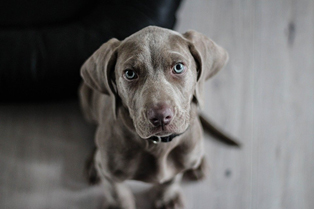
Want to know the secret to a flea-free life? All you have to do is break the cycle. Read on to find out how.
Fleas are those horrible parasites that plague our pets, transmit diseases and, as if that wasn't enough, cause allergic reactions. Often, just when you think you've got rid of them, they reappear out of nowhere, hungry and with one goal: to make your best friend suffer.
Like all insects, these hopping parasites go through several stages of development. In addition to the adult flea, there are the eggs, larvae and pupae, which are known as immature forms and represent the bulk of the problem, as they contaminate the environment where our pet lives. Adult fleas lay their eggs on our pet and these fall off into the environment. By the time you get rid of an adult flea, there are hundreds of immature forms ready to take its place.
We explain below how to break the flea cycle and put a stop to their adventures.
Keys to successful treatment
Any effective treatment needs to attack both the adult fleas―the only ones that actually live on your dog―and the immature forms.
To start with, bear in mind that it may take up to three months before you see the desired results. It's crucial to be realistic and consistent, as one of the main reasons pet owners give up on treatment is that they don't see immediate results.
Remember: perseverance, diligent application, and cleanliness are the best weapons for breaking the flea cycle.
Types of treatment for dog fleas
First of all, you need to be aware that not all drugs attack the same phases of the cycle, so the most effective way is to use a combination of treatments.
Topical treatments
These are substances applied directly to your dog's coat and they come in many forms, from shampoo to collars. They are very convenient and easy to use. The five main types are:
- Spot-on pipettes: these are your best option! They are applied on your pet's back and protect them for several weeks. Most contain an insecticide, which kills adult fleas in as little as 24-48 hours. The best ones, like Dynacan, also contain an IGR molecule, which prevents the development of the immature forms.
- Flea collars: these are made with an insecticide that repels and kills the adult insects. The drug is released slowly and protection lasts several months. They are an excellent option, since they also act as a shield against sandflies and ticks. Some owners object to the fact that many give off a strong smell. If that's a problem for you, try Merlin, as it's odourless.
- Shampoos: these are effective for getting rid of adult fleas. They also have a lasting effect, although not as long as pipettes and collars.
- Sprays: these contain insecticides and have been around for a long time. They are cheaper than other more modern treatments, but less effective (even though they use the same active ingredient as some collars and pipettes). This is because the drug is not evenly distributed and so the dosage isn't very precise. However, the spray is a great help in shock treatments, like when you want to kill adult fleas quickly.
- Powders and talcs: these are very similar to the sprays; they have also been around for a long time and have the same drawbacks.
Oral treatments
These medicines come in the form of a chewable tablet and they attack the flea in three different ways:
- Fast-acting insecticides: these are generally only available to vets and are used to treat severe infestations. They should not be used for a long-term control programme.
- Residual insecticides: these get rid of adult fleas. They need to be given more or less monthly.
- Insecticides against immature forms: these work in a similar way to the IGR molecules. They don't get rid of adult fleas.

Treatments by injection
For the moment, this type of treatment has not been developed for dogs. If you have a cat, you're in luck, because there is an injection form for them.
What treatment should I use?
To treat and prevent flea infestations in dogs, you should use at least two active ingredients: one against the adult flea and the other for the immature forms. As we said, spot-on pipettes are very effective. Dynacan contains an insecticide and an IGR molecule, making it easy to break the cycle. IGR molecules don't affect the adult flea, but using them on your pet means the eggs drop off into the environment but don't hatch. This stops the environment becoming contaminated with immature forms.
There's no doubt that the advantages of topical over oral treatments are their simplicity and ease of use. With topical application, owners can forget fighting their furry friends to get them to swallow the pills. Also, the combination of pipettes and collars provides long-term protection, while the oral treatments have to be administered every month. However, although rare, if the dog develops a skin reaction from a topical treatment, an oral one will have to be used.
When a flea infestation becomes complicated, for example, if your pet develops flea allergy dermatitis, additional treatment with corticosteroids and even antibiotics may be necessary. If this happens, consult your vet!
Cleanliness of the environment is essential
Most flea treatments fail because owners abandon them when they find the fleas don't disappear as quickly as they expect. However, if they are applied well, it's just a matter of patience and perseverance.
And there's nothing like cleaning to speed up the results. Beds, carpets, cushions, toys, collars and leashes, as well as items and clothing that come in contact with your pet should all be washed. Frequent vacuuming of carpets, skirting boards, corners and under furniture goes a long way. It not only removes immature forms from the environment, but the vibrations of the vacuum cleaner cause the pupae to emerge from their cocoons, and then they're no longer immune to the treatments.

In severe infestations, it may be necessary to consult a pest control expert.
The great thing about modern products like Dynacan is that, in the majority of cases, that kind of fumigation won't be necessary.
Prevention, even after treatment
Finally, it's important to remember that, even if you apply a treatment properly, your home could be invaded by fleas again. Other dogs, wild animals and especially stray cats are an endless source of infestations. Even a person could have a stowaway flea and pass it on to your pet!
If you want to forget about fleas, remember Dynacan.



